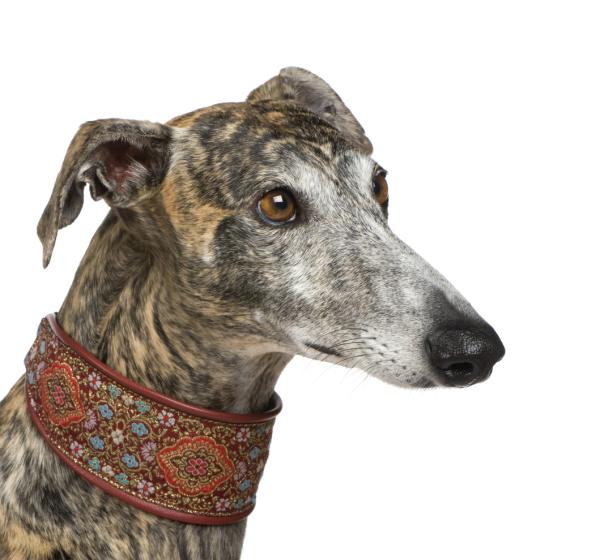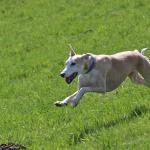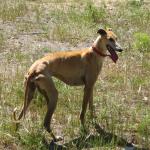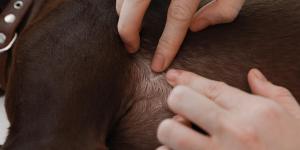Spanish Greyhound

The Spanish Greyhound or Galgo Español is a tall, slender and strong dog originally bred to hunt hares. They are similar to English Greyhounds, but the trained eye can spot several differences.
While the Spanish Greyhound is not yet popular outside of Spain, more and more people have started to adopt them and bring them to their countries. In this AnimalWised file we will tell you all about the Galgo, the perfect choice for people who love to exercise and to spend time outdoors.
- Europe
- Spain
- Group X
- 5-14
- 14-18
- 18-22
- 22-27
- 27-31
- More than 31
- 2-7
- 7-22
- 22-55
- 55-100
- 100-220
- 8-10
- 10-12
- 12-14
- 15-20
- Low
- Meidum
- High
Origin of the Spanish Greyhound
The origin of the Spanish Greyhound is not clear. Some experts suggest that the Ibizan Hound or their ancestors may be the source of this breed, while most believe that the Sloughi, introduced to the Iberian Peninsula during the Umayyad conquest, is the Galgo's main ancestor.
In any case, we do know that the Galgo was a very popular hunting dog in the Middle Ages. Their importance in hunting traditions and aristocratic society cannot be overstated: they appear in many novels and treatises, and even in Francisco de Goya's 18th Century tapestry cartoons.
When greyhound racing became popular in the early 20th Century, the Spanish Greyhound was crossbred with the English Greyhound with the aim of breeding even faster dogs, as the two breeds are considered among the fastest in the world. The result was the Anglo-Spanish Greyhound, which is not recognized by the FCI.
Nowadays, Spanish Greyhounds are mainly used as hunting dogs in their native country, although they are increasingly beloved as pets. Hunting with dogs is a hotly debated practice in Spain, and many animal welfare societies are petitioning its ban because of the cruelty and pain the Galgos are subjected to.
Physical traits of the Spanish Greyhound
Male Galgos reach 62 to 70 cm (24.5 to 27.5 in) to the withers, while females are slightly smaller at 60 to 68 cm (23.5 to 27 in). There is no standard weight range, but they are very light and agile. In general, Spanish Greyhounds are smaller than English Greyhounds. Their body is slender and stylized, with a long head and a long tail, with powerful but thin legs.
Their head is long and thin, like the muzzle, and proportionate to the rest of their body. Both the nose and the lips are black, and they have a scissor bit with developed fangs. Their eyes are small, almond-shaped and oblique, and they are usually dark. Their ears are triangular, with a wide base and a round tip.
Their long neck unites the head to their rectangular, strong and flexible body; their chest is deep, with a streamlined belly. Their back is slightly arched, and the rear is higher than the front, unlike English Greyhounds. Their tail is strong at the base and narrows gradually until the fine tip; it is flexible and very long.
Spanish Greyhounds have a dense, soft, short and flat coat; however, there is also a rough-coated variety with longer hair manifested in a slight beard, mustache and eyebrows. All coat colors are accepted, although dark brindle, toasted, cinnamon, yellow, white, red and patched are preferred. White markings are allowed.
Temperament of the Spanish Greyhound
The Galgo Español is a bit shy, so it is best to socialize them as puppies to prevent them from becoming fearful adults. Even if they are reserved, they are very calm, gentle dogs that usually get along with other dogs, pets and people.
Despite having a strong prey drive, Spanish Greyhounds tend to be friendly with smaller animals, including cats and smaller dogs. If you want a dog but already have another pet, a Galgo is an excellent choice for you.
Caring for a Spanish Greyhound
Galgos Españoles have a life expectancy of about 10 years, but it greatly varies between individuals; companion dogs can easily live for longer, but hunting dogs suffer notable wear and tear. They can live in apartments if they get lots of exercise, but in general they are recommended for homes with gardens.
Their coat does not require much care: it will be enough to brush them regularly to get rid of dead hair and to bathe them if they get dirty.
Training a Spanish Greyhound
Although Spanish Greyhound do not usually take the spotlight in dog training, their gentleness makes them easy to train. With positive reinforcement, your Galgo will be perfectly able to learn the basic dog commands and more.
Common health problems of Spanish Greyhounds
This is a relatively healthy breed, although you must watch out for the common diseases and conditions of sighthounds and large breeds, such as hip dysplasia, bone cancer and especially gastric torsion. It is best to place their food bowls above floor level so that they don't have to bow down their long necks.
Spanish Greyhound photos




















